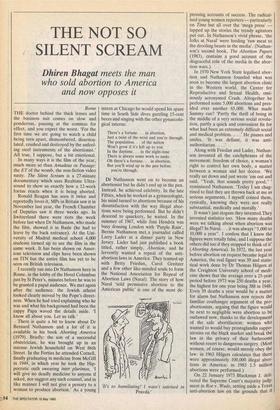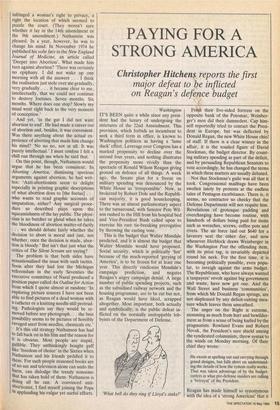THE NOT SO SILENT SCREAM
Dhiren Bhagat meets the man
who sold abortion to America and now opposes it
Rome THE doctor behind the thick lenses and the business suit comes on slow and ponderous, pausing at the commas for effect, and you expect the worst. 'For the first time we are going to watch a child being torn apart, dismembered, disarticu- lated, crushed and destroyed by the unfeel- ing steel instruments of the abortionist.' All true, I suppose, but a bit emotional.
In many ways it is the film of the year, much more so than Amadeus or Passage: the ET of the womb, the non-fiction video nasty. The Silent Scream is a 27-minute documentary which uses Realtime Ultra- sound to show us exactly how a 12-week foetus reacts when it is being aborted.
Ronald Reagan has seen it twice and reportedly loves it, MPs in Britain saw it in November last year, the French Chamber of Deputies saw it three weeks ago. In Switzerland there were riots the week before last when Dr Nathanson, who made the film, showed it in Basle (he had to leave by the back entrance). At the Uni- versity of Madrid medical school 4,000 students turned up to see the film in the same week. It has been shown on Amer- ican television and clips have been shown on ITN but the entire film has yet to be seen on British television.
I recently ran into Dr Nathanson here in Rome, in the lobby of the Hotel Columbus just by St Peter's, minutes before he was to be granted a papal audience. We met again after the audience: the Jewish atheist looked clearly moved by the Pope's direct- ness. When he had tried explaining who he was and what his background had been the zappy Papa waved the details aside. 'I know all about you. Let us talk.'
There is quite a bit to know about Dr Bernard Nathanson and a lot of it is available in his book Aborting America (1979). Briefly: the son of a successful obstetrician, he was brought up in an intense Jewish household on West 86th Street. In the Forties he attended Cornell, finally graduating in medicine from McGill in 1949, in which year he took the Hip- pocratic oath swearing inter plurimos, 'I will give no deadly medicine to anyone if asked, nor suggest any such counsel, and in like manner I will not give a pessary to a woman to produce abortion.' As a young intern at Chicago he would spend his spare time in South Side dives guzzling 15-cent beers and singing with the other gynaecolo- gical interns:
There's a fortune. . . in abortion, Just a twist of the wrist and you're through.
The population. . . of the nation Won't grow if it's left up to you.
In the daytime. . . in the night-time There is always some work to undo.
Oh there's a fortune. . . in abortion, But you'll wind up in the pen before you're through.
Dr Nathanson went on to become an abortionist but he didn't end up in the pen. Instead, he achieved celebrity. In the late Fifties, when he worked as a gynaecologist, his mind turned to abortions because of his dissatisfaction with the way illegal abor- tions were being performed. But he didn't descend to quackery, he waited. In the summer of 1967, while Jimi Hendrix was busy dousing London with 'Purple Rain', Bernie Nathanson met, a journalist called Larry Lader at a dinner party in New Jersey. Lader had just published a book titled, rather simply, Abortion, and he fervently wanted a repeal of the anti- abortion laws in America. They teamed up with Betty Friedan, Carol Greitzer and a few other like-minded souls to form the National Association for Repeal of Abortion Laws (Naral). The story of how Naral 'sold permissive abortion to the American public' is one of the most de- 'It's so humiliating! I wasn't satirised in Pravda.' pressing accounts of success. The radical- ised young women reporters — particularly on Time but all over the 'mega press' lapped up the stories the trendy agitators put out. In Nathanson's vivid phrase, 'the folks at Naral' were feeding 'raw meat to the drooling beasts in the media'. (Nathan- son's second book, The Abortion Papers (1983), contains a good account of the disgraceful role of the media in the abor- tion wars.) In 1970 New York State legalised abor- tion and Nathanson founded what was soon to become the largest abortion clinic in the Western world, the Center for Reproductive and Sexual Health, omi- nously acronymed Crash. Altogether he performed some 5,000 abortions and pres- ided over another 65,000. What made Sammy run? 'Partly the thrill of being in the middle of a very serious social revolu- tion, partly a quick and convenient fix for what had been an extremely difficult social and medical problem. . . .' He pauses and smiles. 'It was defiant, it was anti- authoritarian. . .
Along with Friedan and Lader, Nathan- son invented all the catchphrases of the movement: freedom of choice, a woman's right to control her own body, a matter between a woman and her doctor. 'We really sat down and just wrote 'em out and said, "Yeah, that sounds pretty good," ' reminisced Nathanson. 'Today I am chag- rined to find they are thrown back at me as serious arguments. I myself coined them, cynically, knowing they were not really substantial, medically and morally.'
It wasn't just slogans they invented.They invented statistics too. 'How many deaths were we talking about when abortion was illegal? In Naral. . . it was always "5,000 to 10,000 a year". I confess that I knew the figures were totally false, and I suppose the others did too if they stopped to think of it' (Aborting America). In 1972, the last year before abortion on request became legal in America, the real figure was 39 and statis- tical work done by Dr Thomas Hilgers at the Creighton University school of medi- cine shows that the average over a 25-year period before 1973 was 250 deaths a year, the highest for one year being 388 in 1948. Even 39 deaths a year would be a matter for alarm but Nathanson now rejects the familiar coathanger argument of the pro- abortionists, arguing that the figure would be next to negligible were abortion to be outlawed now, thanks to the development
of the safe abortifacient: women who wanted to would buy prostaglandin suppo-
sitories on the black market and break the law in the privacy of their bathrooms without resort to dangerous surgery. (Most women, of course, would merely obey the law: in 1963 Hilgers calculates that there were approximately 100,000 illegal abor- tions in America: in 1983 1.5 million abortions were performed.) On 22 January 1973 Blackmun J. deli- vered the Supreme Court's majority judg- ment in Roe v. Wade, setting aside a Texas anti-abortion law on the grounds that it infringed a woman's right to privacy, a right, the location of which seemed to puzzle the court. (They weren't sure whether it lay in the 14th amendment or the 9th amendment.) Nathanson was pleased. In a year, however, he was to change his mind. In November 1974 he published his volte face in the New England Journal of Medicine, an article called `Deeper into Abortion'. What made him turn against abortion? 'There was certainly no epiphany. I did not wake up one morning with all the answers . . . I think the realisation just stole over me gradually, very gradually . . . it became clear to me, intellectually, that we could not continue to destroy foetuses. Seven months. Six months. Where does one stop? Slowly my mind went right back to the very moment of conception.'
And yet, 'in the gut I did not want abortion to end'. He had made a career out of abortion and, besides, it was convenient. Was there anything about the actual ex- perience of aborting that made him change his mind? 'No no no, not at all. It was purely intellectual.' I must confess I felt a chill run through me when he said that. 1 On this point, though, Nathanson would argue that he has been consistent. In Aborting America, dismissing specious arguments against abortion, he had writ- ten: 'Anti-abortionists seem to delight especially in printing graphic descriptions of what abortion does to [the foetus] . . . who wants to read graphic accounts of amputation, either? Any surgical proce- dure so described plays upon the squeamishness of the lay public. The physi- cian is no butcher or ghoul when he takes the bloodiness of abortion matter-of-factly • . . we should debate fairly whether the decision to abort is moral and just, not whether, once the decision is made, abor-' tion is bloody.' But isn't that just what the critics of The Silent Scream are saying? The problem is that both sides have sensationalised the issue with such tactics.
Soon after they had lost the Michigan referendum in the early Seventies the executive committee of Naral produced a position paper called An Outline for Action from which I quote almost at random: 'In exploring picture sources I have not been able to find pictures of a dead woman with a catheter or a knitting needle still protrud- ing. Pathologists say they would be re- moved before any photograph. . . the best possibility seems to be pictures of horribly ravaged uteri from needles, chemicals etc.'
It's this old strategy Nathanson has had to fall back on in his film and the reason for it is obvious. Most people are stupid, gullible. They unthinkingly bought guff like 'freedom of choice' in the Sixties when Nathanson and his friends peddled it to them. For such people reasoned books are of no use and television alone can undo the harm, can dislodge the trendy nonsense that has taken hold of them. Nathanson is doing all he can. A convinced anti- abortionist, I find myself joining the Pope in applauding his vulgar yet useful efforts.















































 Previous page
Previous page